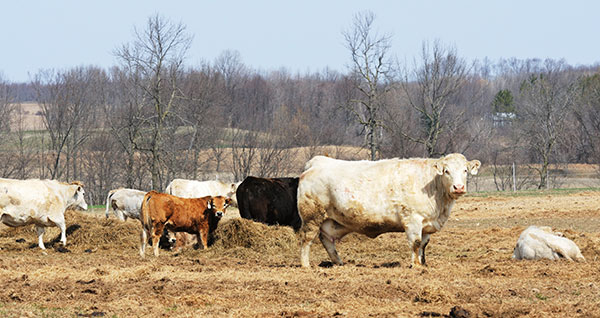
Feeding hay to pastured cattle during winter provides a situation with a lot of opportunity to waste stored hay supplies. Waste can never be eliminated, but it can be managed and minimized.
"Loss, associated with feeding hay to livestock, may be much more than just storage loss if precautions are not taken to reduce waste during the feeding operation," says Mark Landefeld, extension educator in Monroe County, Ohio. Beef cattle producers in his area are feeding more stored hay this winter because of dry fall conditions that limited stockpiled pasture growth.
In a recent Ohio Beef Cattle Letter, Landefeld explains that trampling, leaf shatter, quality deterioration, fecal contamination and animal refusal are all factors that contribute to waste. The amount of waste, which can range from 2 to more than 60 percent, mostly hinges on how the hay is offered to livestock. "To get feeding losses down to a normal range of 3 to 6 percent, it takes good management," notes Landefeld.
Feeding systems that keep hay from contacting the ground generally have the lowest waste. There are a variety of feeding wagons, bunks and bale rings on the market. When picking a location, choose a dry, well-drained or frozen area; then limit hay fed to a one-day supply with adequate space for all animals to eat at the same time.
One strategy for winter feeding is simply unrolling round bales on the ground in different pasture areas. In addition to providing feed, this method helps spread around manure and seed to areas with poor vegetative growth. When using this approach, Landefeld suggests only unrolling a one day's supply or to use an electric wire over the middle of the unrolled swath to prevent hay trampling and bedding. Though the uneaten hay is left to provide organic matter, this strategy also can result in a rather large amount of feed wastage.
Finally, when making your winter feeding plan, allocate stored hay reserves based on forage quality and livestock nutritional needs. "The highest quality hay should be fed to young, growing livestock or lactating animals. Lower quality hay can be fed to livestock with reduced nutritional needs such as bulls and nonlactating cows," says Landefeld. He also suggests lower quality hay can be fed in combination with stockpiled grasses, which often maintain a reasonable level of crude protein and total digestible nutrients.

